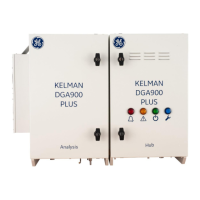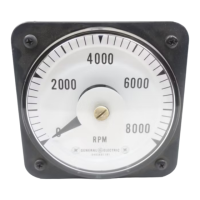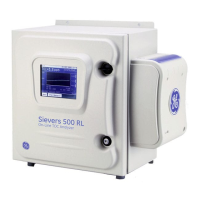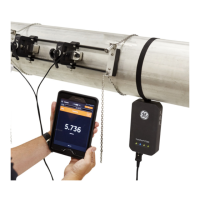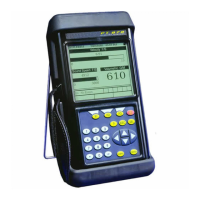5-12 Issue 01, 04/2005 Krautkramer USM 35X
Operation
FINE G (Fine adjustment of gain)
This function serves for the fine adjustment of the cur-
rent gain value. The fine adjustment is possible over a
range of 40 steps within the range of approx. 4 dB. The
displayed gain value will not change.
Adjustment range: –10 ... +30
– Select the function FINE G.
– Use the right-hand rotary knob to adjust the value for
the fine gain.
dBSTEP
Use this function to set a step size for the gain vari-
ation by means of the key . The value set here is
subsequently available to you as the sixth step for the
stepwise gain variation. You have a free choice of the
value within the setting range.
Setting range: 6.5 ... 20 dB
– Select the function dBSTEP.
– Set the value for the gain by means of the right-hand
rotary knob.
REJECT
The function REJECT allows you to suppress unwanted
echo indications, for example structural noise from your
test object.
The % screen height setting indicates the minimum
height that the echoes should attain in order for them to
be displayed on the screen at all. The Reject setting
cannot be higher than the lowest threshold setting
(minus 1 %) of any gate.
A Attention:
You should handle this function with great caution, as it
may of course happen that you suppress echoes from
flaws as well. Many test specifications expressly forbid
using the reject function.
– Select the function REJECT.
– Set the required percentage value by means of the
right-hand rotary knob.
The LED R is therefore lit with active REJECT function.
Adjusting the receiver (function group RECV)
5-12 Issue 01, 04/2005 Krautkramer USM 35X
Operation
FINE G (Fine adjustment of gain)
This function serves for the fine adjustment of the cur-
rent gain value. The fine adjustment is possible over a
range of 40 steps within the range of approx. 4 dB. The
displayed gain value will not change.
Adjustment range: –10 ... +30
– Select the function FINE G.
– Use the right-hand rotary knob to adjust the value for
the fine gain.
dBSTEP
Use this function to set a step size for the gain vari-
ation by means of the key . The value set here is
subsequently available to you as the sixth step for the
stepwise gain variation. You have a free choice of the
value within the setting range.
Setting range: 6.5 ... 20 dB
– Select the function dBSTEP.
– Set the value for the gain by means of the right-hand
rotary knob.
REJECT
The function REJECT allows you to suppress unwanted
echo indications, for example structural noise from your
test object.
The % screen height setting indicates the minimum
height that the echoes should attain in order for them to
be displayed on the screen at all. The Reject setting
cannot be higher than the lowest threshold setting
(minus 1 %) of any gate.
A Attention:
You should handle this function with great caution, as it
may of course happen that you suppress echoes from
flaws as well. Many test specifications expressly forbid
using the reject function.
– Select the function REJECT.
– Set the required percentage value by means of the
right-hand rotary knob.
The LED R is therefore lit with active REJECT function.
Adjusting the receiver (function group RECV)
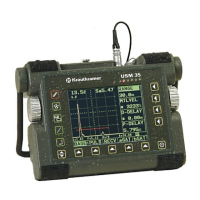
